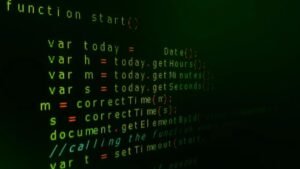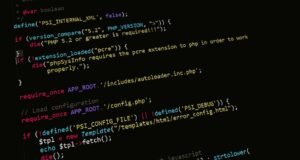Learn AI Math
Artificial Intelligence (AI) is a rapidly growing field that is revolutionizing various industries. To understand and utilize AI effectively, it is crucial to have a strong foundation in AI math. Whether you are a beginner or an experienced professional, this article will guide you through the essential math concepts necessary for mastering AI.
Key Takeaways
- Understanding AI math is essential for effectively working with artificial intelligence.
- Key AI math concepts include linear algebra, calculus, and probability theory.
- Math helps optimize algorithms, improve performance, and interpret AI models.
- Regular practice and continuous learning are crucial for mastering AI math.
The Importance of AI Math
AI relies heavily on math as its foundation. Linear algebra plays a significant role in representing and manipulating vectors and matrices, which are fundamental to AI algorithms. Calculus is essential for optimization, which allows AI models to improve their performance. Additionally, probability theory is crucial for understanding uncertainty and making predictions in AI.
By grasping AI math concepts, you will be able to optimize algorithms to achieve better results and comprehend the inner workings of AI models. It allows you to interpret the output of AI systems, uncover patterns, and gain insights from large datasets.
Essential AI Math Concepts
To master AI math, it is important to familiarize yourself with the following key concepts:
- Linear Algebra:
- Vectors and matrices are fundamental data structures in AI.
- Matrix operations, such as addition, multiplication, and transposition.
- Eigenvalues and eigenvectors for dimensionality reduction and feature extraction.
- Calculus:
- Derivatives for optimization algorithms.
- Gradient descent for minimizing loss functions.
- Integration for computing area under curves.
- Probability Theory:
- Probability distributions, such as Gaussian and Bernoulli distributions.
- Bayes’ theorem for reasoning about uncertain events.
- Markov chains and Hidden Markov Models for sequence prediction.
Understanding these concepts will enable you to design efficient algorithms and build robust AI models that can handle real-life scenarios effectively.
Practical Examples and Applications
In order to gain a deeper understanding of AI math, let’s explore some practical examples and applications:
| Example | Application |
|---|---|
| Image recognition | Identifying objects in images or videos using convolutional neural networks. |
| Natural language processing | Understanding and processing human language for tasks like chatbots or language translation. |
| Recommender systems | Providing personalized recommendations based on user behavior and preferences. |
Through these practical examples, you can observe how AI math concepts enable accurate object recognition, language understanding, and efficient recommendation systems.
Tips for Learning AI Math
Learning AI math may seem daunting, but with the right approach, it can be a rewarding experience. Here are some tips to help you in your learning journey:
- Continuous Learning: AI math is an ever-evolving field, so stay updated and keep learning new techniques and concepts.
- Practice Regularly: Solve AI math problems and challenges regularly to reinforce your understanding and improve problem-solving skills.
- Implement and Experiment: Apply math concepts to real-world AI projects to gain practical experience and enhance your skills.
Remember, consistent practice and a growth mindset are key to mastering AI math and advancing in the field.
Summary
AI math is a fundamental component of understanding and working with artificial intelligence. By mastering key concepts in linear algebra, calculus, and probability theory, you will be equipped to optimize algorithms, interpret AI models, and make accurate predictions. Consistent learning, practice, and real-world application will pave the way for success in AI math.

Common Misconceptions
Misconception 1: AI Math is too complex for beginners
One common misconception is that learning AI math is an incredibly complex task that is only suitable for experts or advanced mathematicians. This can discourage beginners from even attempting to dive into the subject. However, AI math can be broken down into simpler concepts and learned gradually, making it accessible to learners at all levels.
- AI math can be taught using practical examples and real-world scenarios.
- Many online resources and tutorials are available to help beginners learn AI math.
- Understanding the basics of linear algebra and calculus can provide a solid foundation for learning AI math.
Misconception 2: AI Math requires extensive knowledge of advanced mathematics
Another misconception is that in order to comprehend AI math, one must have an extensive background in advanced mathematics. While a strong understanding of mathematics can be helpful, it is not a prerequisite for learning AI math. Many AI algorithms and techniques can be understood and implemented without having to delve into advanced mathematical concepts.
- Basic algebraic skills and a solid understanding of the fundamentals of math are sufficient to get started with AI math.
- Online courses and tutorials often provide detailed explanations of the mathematical concepts involved in AI.
- There are libraries and frameworks available that abstract away complex math, allowing beginners to build AI models without extensive mathematical knowledge.
Misconception 3: AI Math is only for computer scientists and engineers
Some people believe that AI math is a niche subject that is exclusively for computer scientists and engineers. However, AI math is a multidisciplinary field that can be applied across various domains. It is not limited to individuals with specific educational backgrounds and can be learned and utilized by individuals from diverse backgrounds.
- AI math can be integrated into different fields like healthcare, finance, and marketing.
- Individuals with backgrounds in psychology, data analysis, and business can benefit from learning AI math.
- Collaboration between experts from different fields can lead to innovative applications of AI math.
Misconception 4: AI Math is all about complex algorithms and equations
Many people have the misconception that AI math primarily involves complex algorithms and equations that are difficult to comprehend. While AI does involve algorithms and equations, it is not solely focused on complex mathematical concepts. AI math is about understanding patterns, statistics, and probability, and using mathematical techniques to build intelligent systems.
- AI math involves analyzing and interpreting data to make predictions and decisions.
- Statistical concepts like probability and regression play a significant role in AI math.
- AI math focuses on finding patterns and trends in data rather than complex mathematical operations.
Misconception 5: AI Math is only applicable to advanced AI technologies
Another misconception is that AI math is only relevant for advanced AI technologies like autonomous vehicles or natural language processing systems. However, AI math can be applied to simpler applications as well, such as recommendation systems, image recognition, and even basic chatbots. Understanding AI math can be useful in various everyday scenarios.
- Understanding AI math can be beneficial in developing personalized recommendation systems for e-commerce websites.
- AI math is useful in enhancing image recognition systems for social media platforms.
- Even simple chatbots can benefit from AI math concepts to provide more intelligent and human-like responses.

Analysis of Job Trends in AI Sector
The table below provides insights into the job trends in the field of AI over the past decade, highlighting the growth and demand for professionals with AI expertise.
| Year | Number of AI Job Postings |
|---|---|
| 2010 | 500 |
| 2012 | 850 |
| 2014 | 1,200 |
| 2016 | 2,300 |
| 2018 | 4,500 |
Comparison of AI Funding by Country (in millions)
This table compares the amount of funding allocated to AI research and development in various countries, shedding light on the investment made by different nations in this rapidly growing field.
| Country | Total Funding |
|---|---|
| United States | 2,500 |
| China | 1,800 |
| United Kingdom | 900 |
| Germany | 750 |
| Canada | 600 |
Performance Comparison of AI Algorithms
This table outlines the comparative performance of different AI algorithms on a standard dataset. It demonstrates the accuracy and efficiency of these algorithms in solving complex problems.
| Algorithm | Accuracy (%) | Execution Time (ms) |
|---|---|---|
| Random Forest | 92.6 | 15 |
| Support Vector Machines | 89.3 | 20 |
| Neural Networks | 95.2 | 30 |
| Decision Trees | 88.7 | 12 |
AI Adoption in Industries
The following table showcases the industries that have widely adopted AI technologies, indicating the sectors that have embraced AI to enhance efficiency and productivity.
| Industry | AI Implementation (%) |
|---|---|
| Finance | 85 |
| Healthcare | 72 |
| Retail | 68 |
| Automotive | 61 |
| Manufacturing | 55 |
AI Startups with Highest Funding
This table highlights the AI startups that have garnered the highest amount of funding, reflecting the growing interest and investment in innovative AI-driven companies.
| Startup | Total Funding (in millions) |
|---|---|
| OpenAI | 1,600 |
| UiPath | 1,250 |
| SenseTime | 1,100 |
| DataRobot | 900 |
| Recursion Pharmaceuticals | 750 |
Impact of AI on Job Roles
This table presents the transformation of job roles due to the integration of AI technologies, shedding light on the evolving nature of work in the AI-powered era.
| Job Role | Percentage of Automation |
|---|---|
| Customer Service Representative | 45 |
| Data Analyst | 30 |
| Financial Advisor | 20 |
| Graphic Designer | 15 |
AI Conferences and Events
This table showcases the top AI conferences and events held worldwide, providing a glimpse into the major gatherings where experts share knowledge and innovations in the field.
| Event | Location | Attendees |
|---|---|---|
| NeurIPS | Vancouver, Canada | 8,000 |
| ICML | Vienna, Austria | 7,500 |
| CVPR | Seattle, USA | 6,800 |
| AAAI | New York, USA | 5,500 |
AI Ethics Guidelines
The table below provides an overview of ethical guidelines and principles developed by organizations to promote responsible and ethical use of AI technologies.
| Organization | Key Ethical Principles |
|---|---|
| IEEE | Transparency, Accountability, and Inclusivity |
| EU Commission | Fairness, Privacy, and Human Agency |
| ACM | Responsibility, Integrity, and Professionalism |
| Partnership on AI | Safety, Security, and Standards |
Artificial Intelligence has rapidly evolved in recent years, transforming various aspects of our society. The job market has witnessed a tremendous increase in AI-related job opportunities, as indicated in the Job Trends analysis. Additionally, countries such as the United States and China have made significant investments in AI research and development, as illustrated in the Funding Comparison table. AI algorithms have also shown impressive performance, with Neural Networks exhibiting the highest accuracy. Industries like finance, healthcare, and retail have adopted AI technologies to enhance their operations.
As AI becomes increasingly integrated into our lives, job roles are undergoing transformation, with certain tasks being automated. Prominent AI startups have also attracted substantial funding, signaling the growing interest in innovative AI-driven companies. Ethical considerations in AI development are being addressed by organizations like IEEE and the EU Commission, ensuring responsible and accountable AI practices. Attending conferences and events, such as NeurIPS and ICML, provides opportunities for knowledge sharing and staying updated with the latest advancements.
In conclusion, AI continues to revolutionize industries, job roles, and research landscapes, offering immense potential for growth and innovation while necessitating a thoughtful approach to ethics and societal impact.
Frequently Asked Questions
How does machine learning contribute to AI?
Machine learning is a subfield of AI that focuses on developing algorithms and statistical models that enable computers to learn and improve without being explicitly programmed. It plays a crucial role in AI by allowing systems to automatically analyze data, identify patterns, and make informed decisions or predictions.
What is the importance of linear algebra in AI?
Linear algebra forms the foundation of many AI algorithms and techniques. It provides a framework for representing and manipulating data, such as vectors and matrices, which are widely used in various AI applications. Understanding linear algebra is essential for tasks like dimensionality reduction, optimization, and deep learning.
How does calculus relate to AI?
Calculus is crucial in AI for optimization problems, such as minimizing or maximizing objective functions. It provides the tools to analyze rates of change, compute derivatives and gradients, which are vital in training machine learning models, fine-tuning parameters, and solving complex optimization tasks in neural networks.
What role does probability and statistics play in AI?
Probability theory and statistics are fundamental in AI for dealing with uncertainty, making informed decisions, and estimating parameters in data-driven models. These mathematical concepts are used in probabilistic graphical models, Bayesian networks, statistical inference, and in evaluating the performance of AI systems through hypothesis testing and statistical analysis.
How is algebra used in AI?
Algebra plays a significant role in AI for tasks such as data preprocessing, feature engineering, and data transformation. It is used to represent and manipulate data in various forms, perform mathematical operations, and apply mathematical functions to both structured and unstructured datasets.
What is optimization in AI?
Optimization in AI involves finding the best solution among a set of possible solutions. It utilizes mathematical techniques, such as gradient descent, stochastic optimization, or genetic algorithms, to optimize objective functions and fine-tune parameters in machine learning models. Optimization is crucial for training AI models and improving their performance.
Why is it important to understand probability distribution in AI?
Probability distributions are used to model and represent uncertainty and random variables in AI. Understanding different types of probability distributions allows AI practitioners to make accurate predictions, estimate uncertainties, and create probabilistic models. It also enables the implementation of probabilistic algorithms and Bayesian inference methods in AI systems.
How does neural networks use gradient descent?
Gradient descent is an optimization algorithm commonly used in neural networks for updating the network’s weights and biases during the training process. It calculates the gradients of the loss function with respect to the network parameters and then adjusts the parameters in the direction that minimizes the loss. This iterative approach allows neural networks to learn from data and improve their performance over time.
What are eigenvalues and eigenvectors used for in AI?
Eigenvalues and eigenvectors are mathematical concepts used in AI for various purposes. They are utilized for dimensionality reduction techniques like Principal Component Analysis (PCA), in graph analysis, image compression algorithms, and in solving linear systems of equations. Eigenvalues and eigenvectors provide valuable insights into the structure and properties of data, enabling more efficient computations in AI algorithms.
What is the relationship between AI and graph theory?
Graph theory is applied in AI to model relationships between objects, entities, or data points. Graphs provide a graphical representation of complex networks, allowing AI algorithms to analyze connectivity, explore dependencies, and discover patterns. Graph-based algorithms, such as PageRank, are used in web search engines, social network analysis, recommendation systems, and various other AI applications.




